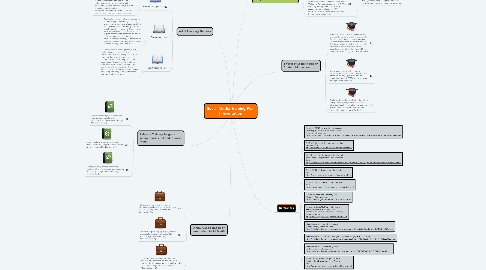
1. Adult Learning Theories
1.1. Multiple Intelligences
1.1.1. Multiple Intelligences is a theory developed by Howard Gardner which posits individuals possess many levels of intelligence, but rely on one or two for active learning (Sierra Training Associates, 2007). This theory supports social media through the use of varied platforms to deliver audiovisual presentations, video conferencing, hands-on simulation, and streaming live demonstrations; which appeal to students and their preferred learning intelligences,
1.2. Cognitivisim
1.2.1. Cognitivism is a theoretical framework for understanding how learning occurs by examining the inner mental activities of the mind (Davey, 2015). This theory supports social media by melding synchronous and asynchronous learning platforms which require individuals to learn through active participation relying on thinking, problem-solving, knowing, and memory to develop an ever evolving schemata. Image retrieved through Mindmeister (n.d.)
1.3. Constructivisim
1.3.1. Constructivism is a learning theory which posits individual learn through a personalized objective reality based upon prior knowledge, past experiences, and cultural perspectives (Davey, 2015). This theory supports social media by allowing individuals to exchange information on social media to construct hypotheses which are tested through social negotiation to develop knowledge. Image retrieved through Mindmeister (n.d.)
2. Ethical Consideration of Integrating Social Media
2.1. Intellectual property and proprietary information may be shared via social media (Chi, 2011). Image retrieved through Mindmeister (n.d.)
2.2. Cross site request forgery may hijack web browsers for malicious purposes (Chi, 2011). Image retrieved through Mindmeister (n.d.)
2.3. Data integrity may be compromised as malware delivered through XML injection may modify databases; reducing validity (Chi, 2011), Image retrieved through Mindmeister (n.d.)
3. Relevant Training Program Competencies Related to Social Media
3.1. Instructional design uses formal and informal learning solutions. (ATD, 2014). Image retrieved through Mindmeister (n.d.)
3.2. Learning technologies uses technology to address learning needs (ATD, 2014). Image retrieved through Mindmeister (n.d.)
3.3. Training delivery focuses on training solutions which are effective and engaging (ATD, 2014). Image retrieved through Mindmeister (n.d.)
4. GoDaddy Social Media Training Integration
4.1. GoDaddy Inc. is a domain name registrar—boasting over 70 million domain names in their portfolio—and technical services provider based in the United States (GoDaddy Operating Company, 2017). The company has approximately 16 million customers and employs over 5,000 individuals internationally. Image retrieved through Mindmeister (n.d.)
4.1.1. This presentation will cover the integration of social media into a training plan to create a positive corporate culture based around training; specifically training will cover new customer relationship management software.

